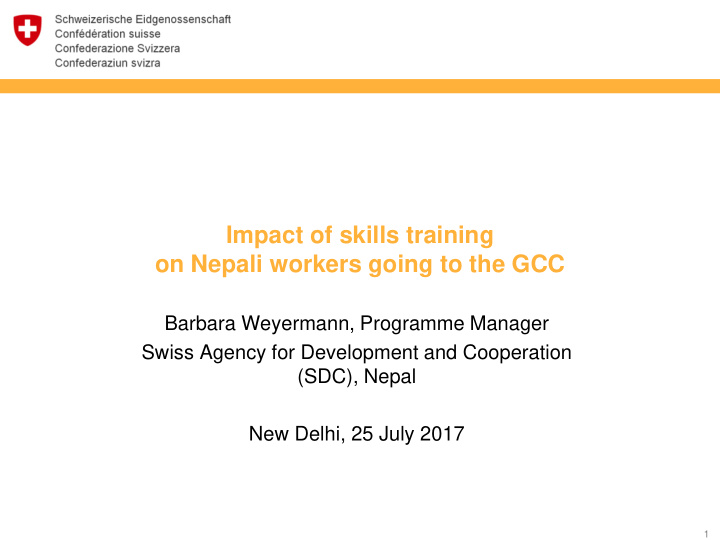



Impact of skills training on Nepali workers going to the GCC Barbara Weyermann, Programme Manager Swiss Agency for Development and Cooperation (SDC), Nepal New Delhi, 25 July 2017 1
Outline Safer Migration: Project set-up and vocational training objectives and modalities Results of tracer study to assess effectiveness of training for migrant workers Training set-up and ist implications on effect of training Conclusions 2
SaMI – Safer Migration Project 2013 - 2018 Reduce Empowerment financial and of migrants social costs Strengthening Increase of economic government benefit mechanisms
Objective of skilling migrants Better employability (access to job, retaining of job) Better salaries than general labour Better prepared for migration Reduction of pre-departure costs 4
SaMI - Skilling migrants Based on Swiss experience: SaMI connects to Swiss experience in skills sector in Nepal (short courses, results based financing) Occupations: mason, shuttering carpentry, scaffolding, plumbing, electrician Curricula : developed in collaboration with a consultant who developed occupational profiles for KOSAC Duration: 1 month Certification: by project Number of trainees: 4’145 between 2013 and mid- 2016 5
Result-based financing Training providers: private companies selected through tender process Result –based financing: Full payment for TP only if trainee obtained employment contract in trained occupation. Employment rate: 75% Modality tested in domestic market : TP is forced to train relevant, marketable skills. Employment rate after 6 months: over 80%; after 3 years: 70% 6
Result-based financing of trainings for foreign labour market Linking trainees to employment : TPs collaborate with recruitment agencies to place the training graduate TP becomes sub-agent: Recruitment Agency sends employer representatives to TP for testing trainees; TP ensures contact between RA and worker until departure SaMI’s conditions : Upper limit of pre-departure costs; minimum salary; same occupation; TP involved by SaMI in case of problems. SaMI’s risk: to become associated with unfair practices of recruitment agencies 7
Tracer Study 2016 – Purpose and Methods Purpose Understand effects of training Methods Focus on electrician helper, plumber helper and scaffolders . 1’636 scaffolders, electrician helpers and plumbers were employed in this period and 1’318 of those in UAE/Qatar Questionnaire to 100 workers in UAE and Qatar (phone interviews); Interviews with stakeholders in UAE (employers, training centers, authorities) 8
Value of training from workers perspective Feed-back from workers Relevance of training content: 86% scaffolders found all content relevant while 50% electricians found all content relevant and 33% found some of it relevant. Tests in destination countries: 20% had to pass a test after arrival. 100% scaffolders passed; 80% electricians passed Qualitative feed-back : 90% rated trainings as useful; increased confidence; provided basis for picking up additional knowledge faster; passing tests, moving up etc. 9
Effect on salaries Official minimum salary set by GoN for UAE is AED 800 (USD 218) and for QAR 900 for Qatar (USD 245) Average salaries: AED 1’082 (USD 295) in UAE and QAR 972 (USD 266) in Qatar Salaries highest for electrician helpers (AED 1’107) and lowest for scaffolders(AED 977) 10
Overtime How often did you work overtime? Always – 65% Sometimes – 31% Never – 9% Basic salary: USD 276 Salary w/overtime: USD 352 Overtime increases salaries by 28% 11
Return on investment Pre-departure costs paid to recruitment agents: Average NPR 58’000 (USD 580) – (GoN: USD 700) Return on investment : Cost of training: USD 350 Additional salary for 24 months: USD 1’084 Training resulted in employability, higher income, lower pre-departure costs and better preparation 12
Effects of abolishing result-based financing Delinking training and placement in 2016 after change of policy in Nepal Tracking in 2017 to compare with linked graduates : Labour permits issued for 36% of graduates only (vs. 75% before) Salaries: QAR 800 (USD 245) if not in occupation that was trained; QAR 950 (USD 260) if in trained occupation Pre-departure costs paid to recruitment agencies considerably higher; additional costs (several times travel to KTM, additional medical test) 45% found to be working in Nepal, often not in trained occupation; average salary USD 150 13
Foreign employment rate Women are only trained on demand 80% Reasons for low departure rate of 70% men: 60% Recruitment agents give 50% preference to candidates that 40% come through sub-agents 30% Salary offered was below 20% QAR/AED 900 10% Recruitment costs were too high 0% Men Women 14
Conclusions Training alone does not lead to higher salaries and better employability Reintroduce results-based financing in the interest of the training graduates and in spite of concerns regarding practices of TPs/recruitment agencies Work towards training on demand Testing and certification to ensure training quality and to provide a more objective basis for salary discussions Systematic tracing and Randomized Controlled Trials 15
Recommend
More recommend